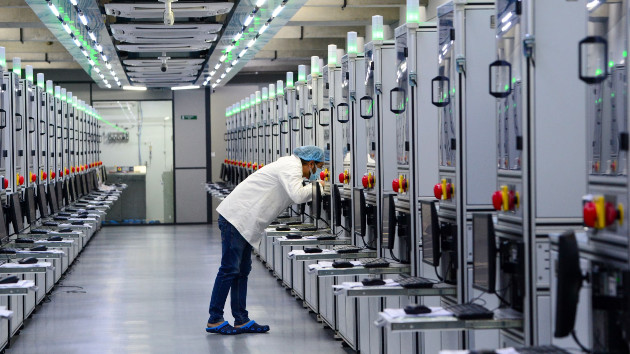Are lab-grown diamonds as sustainable as advertised?


(NEW YORK) — The natural diamond industry has been fueled by a glittering marketing strategy for decades, but is the sustainability of modern, lab-grown diamonds as clear-cut as consumers believe?
Since De Beers Group’s 1940s “a diamond is forever” advertising campaign, dubbed by Advertising Age as the “slogan of the 20th century” in 1999, the natural diamond industry exploded into a multi-billion-dollar industry and cemented itself into modern culture.
“Diamonds are very ingrained in our culture,” Paul Zimnisky, a leading diamond industry analyst, told ABC News. “I think, as humans, we just desire these rare, precious gemstones and metals. It’s not practical, but it makes us feel good.”
In 2022, the global natural diamond market was valued at $100.4 billion and is projected to reach $155.5 billion by 2032, according to Allied Market Research.
However, the natural, mined diamond industry has been disrupted by a just as shiny and substantially less expensive competitor — lab-grown diamonds.
General Electric first produced lab-grown diamonds in 1954, according to the International Gem Society (IGS), using a high-pressure belt press to subject small seed crystals to temperatures of 2,912 Fahrenheit and atmospheric pressures of 100,000 atm.
Over the next several decades, researchers in the United States, China and Russia adopted varied methods of the initial GE patent to create lab-grown diamonds that exceed mined, natural diamonds in carat size, color and clarity, according to IGS.
Demand for lab-grown diamonds has increased every year but gained mainstream attention in 2017, according to Zimnisky.
“Production has just absolutely skyrocketed,” Zimnisky said. “The production technologies in the production capacity have rapidly advanced in just the last three, four years. And because of that, the cost of production is dropped, and the cost to the consumer has dropped.”
To the naked eye, lab-grown diamonds are identical to their mined counterparts but cost 40% to 50% less. A one-carat lab-grown diamond costs about $1,200, depending on quality, while a similar natural diamond can cost $4,200, according to The Diamond Pro.
In 2022, the global lab-grown diamonds market was valued at $24 billion and is projected to reach $59.2 billion by 2032, according to Allied Market Research.
How are lab-grown diamonds made?
Lab-grown diamonds share identical chemical and physical properties with natural diamonds, Dr. Ulrika D’Haenens-Johansson, senior manager of Diamond Research at the Gemological Institute of America, told ABC News, the difference is the origin in which they were made: In a lab vs. being mined after forming 150 miles below the Earth’s surface.
“Laboratory-grown diamonds have the same composition and crystal structure as natural diamonds, resulting in essentially the same physical, chemical and optical properties,” D’Haenens-Johansson said. “While laboratory-grown and natural diamonds may appear identical to the naked eye, they fundamentally differ in several ways: their age, the way that they grew, and the environment in which they formed.”
Lab-grown diamonds mimic the conditions natural diamonds are formed in, where carbon is compressed due to extreme temperatures and pressures.
The manufactured stones are created in two ways: through high pressure/high temperature (HPHT) and chemical vapor deposition (CVD) processes, according to IGS.
Both HPHT and CVD lab-grown diamond productions require recreating temperatures over 1,472 Fahrenheit and atmospheric pressures up to 70,000 atm, according to IGS.
Are lab-grown diamonds sustainable?
The variation in the production of lab-grown diamonds is where the sustainability of the man-made product comes into question, according to Zimnisky, who notes, “Man-made diamonds require an enormous amount of energy.”
“You could go to a producer that’s using coal-fired, grid power, or a producer that’s using hydropower or solar power,” Zimnisky said. “Obviously, the environmental impact is going to be different depending on the source of energy.”
The production of laboratory-grown diamonds is an energy-intensive process, according to D’Haenens-Johansson, who notes, many — if not most — lab-grown diamond producers use electricity from fossil fuels such as coal.
Additionally, D’Haenens-Johansson explained that the raw materials that are used for lab-grown diamond growth, such as methane gas and graphite are “generally intrinsically tied to mining processes.”
On average, producing one polished carat of lab-grown diamond releases approximately 511 kg of greenhouse gases, according to IGS.
Amid the lab-grown diamond industry boom, China and India have risen as the top-producing and exporting countries, relying largely on coal to produce lab-grown diamonds, according to the Natural Diamond Council.
Over 60% of lab-grown diamonds are produced in China and India where 63% and respectively 74% of grid electricity results from coal, the council said in its 2023 analytical report.
“India and China right now are by far the largest producers of the man-made diamond,” Zimnisky said. “I expect them to continue to be the largest producers.”
In 2019, the Federal Trade Commission (FTC) warned eight jewelry marketers that some of their online advertisements of jewelry made with lab-grown diamonds “may deceive consumers,” in violation of the 2018 FTC Act — updated Guides for the Jewelry, Precious Metals, and Pewter Industries.
According to the FTC press release, “the companies in question advertised their jewelry as ‘eco-friendly,’ ‘eco-conscious,’ or ‘sustainable,’ and that such terms can be interpreted to imply certain specific environmental benefits.”
The FTC “admonished” the companies, saying it’s “highly unlikely that they can substantiate all reasonable interpretations of these claims,” according to the release.
Environmental and ethical impact of mined diamonds
Mined diamonds are collected through open-pit, underground and marine mining, which can disrupt ecosystems and release carbon and other greenhouse gases into the atmosphere, according to IGS.
Clean Origin compares the environmental footprint between mined and lab-grown diamonds, claiming one carat of mined diamond equates to nearly 100 square feet of disturbed land and nearly 6,000 pounds of mineral waste.
Meanwhile, one carat of lab-grown diamond disrupts just 0.07 square feet of land and results in 1 pound of mineral waste, according to Clean Origin.
Diamond mines are also dangerous for workers, with the mines being vulnerable to collapse and explosions, according to Clean Origin, which notes increased cancer risk, hearing loss, lung problems and other health issues are associated with diamond mining.
The term “blood diamonds,” also known as conflict diamonds, originated in the African countries Angola, the Democratic Republic of the Congo and Sierra Leone in the 1990s, according to Britannica.
Rebel groups used forced labor in lucrative diamond mining war zones to finance armed conflicts, which led to widespread human rights abuse, according to Britannica.
In 2003, the Kimberly Process was enacted to stop the illegal trade of conflict diamonds and protect the legitimate diamond trade, according to Britannica, which notes the agreement involves 49 participating countries including the European Union.
Why brands and consumers believe in lab-grown diamonds
Alexander Weindling, a third-generation diamond jeweler and CEO of Clean Origin, a completely lab-grown diamond company, told ABC News the ethos and affordability of lab-grown diamonds motivate his business.
Weindlings says a one-carat mined diamond can retail for $4,000 or $5,000, while Clean Origin offers what appears to be an identical stone for under $1,000.
However, regarding the sustainability and environmental effect of the industry, Weindling was careful to dub lab-grown diamonds “green-ish.”
“How many greenish alternatives are less expensive than the old technology they’re displacing?” Weindling asked. “A Tesla costs more than a Ford, and an organic apple costs more than a Costco apple.”
“So we have, what I believe to be, if not a more sustainable than a far less disruptive product on so many levels. And it’s less expensive,” Weindling said, adding, “It’s a win-win.”
Melissa Jawaharlal, the co-owner of STEM Center USA and bride-to-be in Southern California, told ABC News choosing an engagement ring with less ethical and environmental impact was important to her.
“We all make a footprint, and I know every one of my choices has implications,” Jawaharlal said. “Choosing a lab-grown diamond was a way to still have that sparkle, have that symbol of love — but do it in a way that wasn’t going to feel ethically compromising.”
In terms of “eco-friendly” and “sustainable” marketing, Jawaharlal believes “clarity and transparency in marketing is always so important.”
“If it’s not done that way, it’s just going to hurt the industry more later on,” she added.
Looking to the future of the lab-grown diamond industry, Weindling believes that advances in sustainability are on the horizon, but in the meantime, “Don’t let the perfect be the enemy of the good.”
“Evolution is perfect,” Weindling added.
Copyright © 2024, ABC Audio. All rights reserved.






